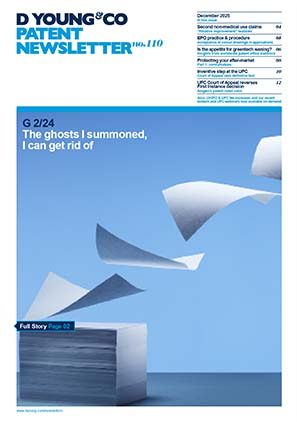Patenting in an era of infrastructure renaissance: insights from Europe
In 2025, Germany amended its constitution to create a staggering €500 billion fund for infrastructure modernisation. This is the largest single investment of its kind in the country’s post-war history. Meanwhile, the United Kingdom is embarking on a £725 billion national infrastructure plan. These twin economic blueprints are reshaping not just roads and railways but the very landscape of innovation. For companies operating in or targeting these markets, this means that European patent coverage is important and understanding the patent implications of these initiatives could define competitive success for decades to come.
Infrastructure investment is often viewed through the lens of concrete, steel, and public works. However, it is also a powerful catalyst for innovation. The UK and Germany, Europe's two largest economies, are currently undertaking unprecedented infrastructure overhauls aimed at revitalising transport, energy, digital connectivity, and social services. These plans are not just economic recovery tools; they are strategic investment vehicles shaping industrial policy, technology development, and regulatory frameworks.
This article explores how the scale and nature of infrastructure spending in these two countries is influencing corporate patent strategy in Europe.
Infrastructure spend: scale and scope
United Kingdom
Over the last 15 years, the UK has steadily increased public infrastructure investment, with annual capital allocations rising from roughly £20-25 billion in the early 2010s to approximately £28.9 billion in 2024. The most ambitious commitment yet is the £725 billion plan spanning a decade, covering areas from energy networks and transportation to housing and digital infrastructure.
Germany
Historically conservative in infrastructure outlays, Germany is now reversing course. The €500 billion constitutional special fund (running through 2036) includes €100 billion earmarked for climate and energy transition technologies and €400 billion for transport, hospitals, broadband, and bridges. Annual spending is expected to reach €35 billion by 2029, including significant allocations for rail, digital connectivity, and environmental resilience.Patent strategy implications
New markets
Traditionally, the US has been an important market for companies focused on infrastructure projects. The annual spend in the US on infrastructure projects is around $500Billion. However, with this focus on infrastructure spending in Europe’s two largest economies, the European market is now increasingly important. This means that companies may need to now focus on protecting their innovation in Europe which, traditionally, may not have been an important market for them.
Sectoral innovation
The sectors prioritised by infrastructure programmes—such as clean energy, hydrogen technology, smart mobility and broadband, amongst others—are inherently innovation-intensive. Companies developing novel solutions in these areas should proactively file patents to secure early-mover advantage. For instance, patents in AI-driven grid management or bridge stress sensors could prove strategically valuable as procurement specifications evolve. Moreover, as these areas of innovation may rely on computer-implemented inventions more than ever, it is important for a company to seek advice early on the nuances of European practice in this area, especially if the company has historically focused on developing innovation in more mechanical areas of technology.
Cross-jurisdiction protection
The cross-border nature of many infrastructure projects (e.g., the NeuConnect interconnector linking UK and German energy grids) means that patent strategies must be multi-jurisdictional. So, claims should be drafted to ensure that all infringing acts are carried out in one jurisdiction. In other words, system claims which typically have one act performed in one jurisdiction and a second act performed in a different jurisdiction should be avoided as far as possible. Instead, the claims should be drafted so that the component parts of the system are individually protected. In Europe, these can be protected in the same application if the component parts are interrelated products.
Further, given the cross-jurisdictional nature of these projects, careful consideration should be given to geographical protection. It is worth remembering that protection in the UK and Germany (together with a large number of other states) is available via a single patent grant procedure at the European Patent Office (EPO). For large-scale cross-jurisdictional projects, companies may wish to obtain a Unitary Patent which covers a large number of countries in one patent.
Time-phased patent activity
Although the infrastructure projects will be ultimately deployed in many years’ time, the decisions about patent protection in Europe should be considered much sooner.
In Germany, given the €35 billion annual ramp-up through 2029 and full deployment of the €500 billion fund through 2035, companies should front‑load filings by 2027–29, to align with procurement and project start-up. Similarly, in the UK, as the £725 billion plan is rolled out over the next decade, early tenders (for example, Lower Thames Crossing and climate retrofits) are being carried out now.
Sovereign immunity and enforcement
Enforcing patents against public bodies or state contractors can raise sovereign immunity issues. In the UK, Section 7(b) of the State Immunity Act 1978 does not provide an immunity for the State from patent infringement proceedings. Therefore, it is possible to bring patent infringement proceedings against the UK Government. However, other jurisdictions may have different legislation and this should be considered.
Conclusion
Infrastructure investment in the UK and Germany is about more than construction; it is a stimulus for innovation and a redefinition of national technological capabilities. For companies operating in these spheres, patents are not merely protective tools but are strategic assets. Careful consideration should be given by companies to align their IP strategies with the trajectories of these monumental public investment programmes.

